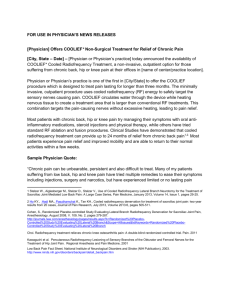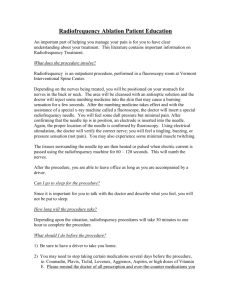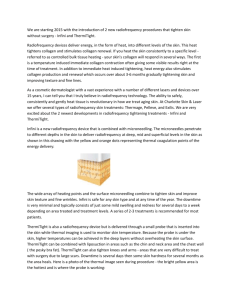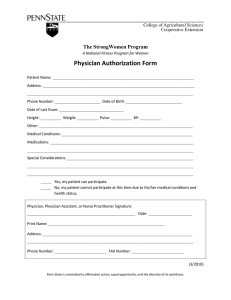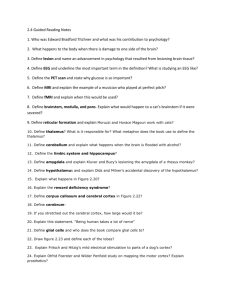Radiofrequency Lesioning “ Low back pain is the most common type
advertisement
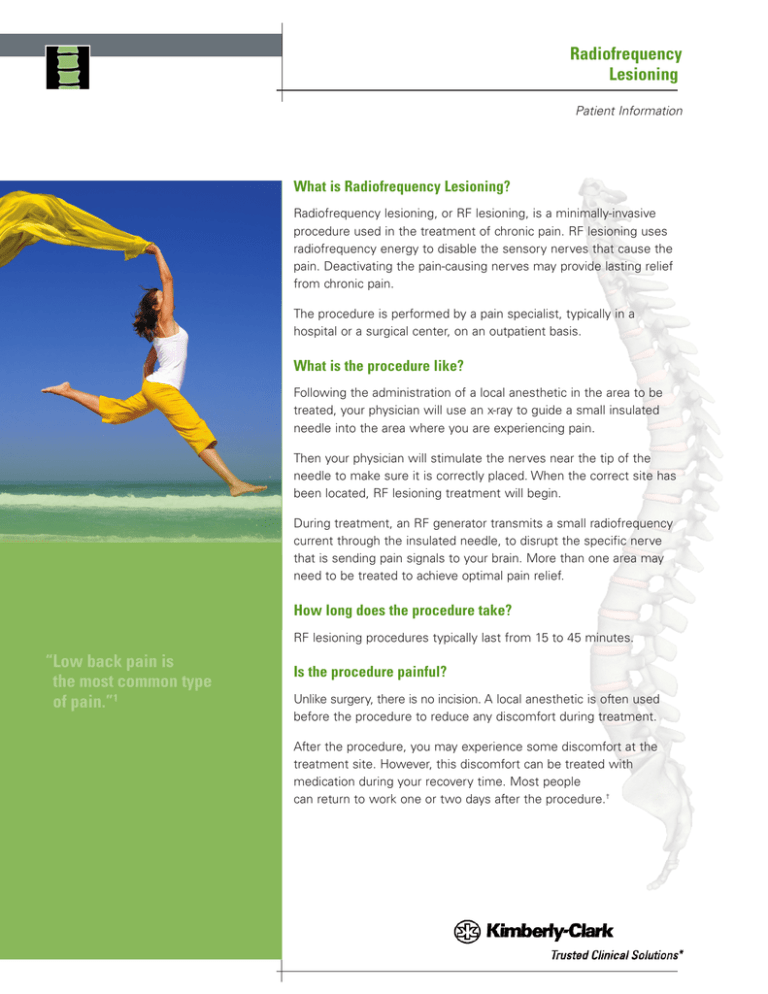
Radiofrequency Lesioning Patient Information What is Radiofrequency Lesioning? Radiofrequency lesioning, or RF lesioning, is a minimally-invasive procedure used in the treatment of chronic pain. RF lesioning uses radiofrequency energy to disable the sensory nerves that cause the pain. Deactivating the pain-causing nerves may provide lasting relief from chronic pain. The procedure is performed by a pain specialist, typically in a hospital or a surgical center, on an outpatient basis. What is the procedure like? Following the administration of a local anesthetic in the area to be treated, your physician will use an x-ray to guide a small insulated needle into the area where you are experiencing pain. Then your physician will stimulate the nerves near the tip of the needle to make sure it is correctly placed. When the correct site has been located, RF lesioning treatment will begin. During treatment, an RF generator transmits a small radiofrequency current through the insulated needle, to disrupt the specific nerve that is sending pain signals to your brain. More than one area may need to be treated to achieve optimal pain relief. How long does the procedure take? RF lesioning procedures typically last from 15 to 45 minutes. “Low back pain is the most common type of pain.”1 Is the procedure painful? Unlike surgery, there is no incision. A local anesthetic is often used before the procedure to reduce any discomfort during treatment. After the procedure, you may experience some discomfort at the treatment site. However, this discomfort can be treated with medication during your recovery time. Most people can return to work one or two days after the procedure.† Radiofrequency Lesioning Am I a candidate for Radiofrequency Lesioning? If you have chronic pain, only your physician can decide whether this procedure is right for you. Your physician may use nerve blocks to see if you might respond to RF lesioning treatment. How long does pain relief last after Radiofrequency Lesioning? RF lesioning may provide the pain relief you need to allow you to resume your daily activities. Pain relief usually lasts for 3-24 months.† On occasion, your body may regenerate the nerve or nerves responsible for sending pain signals to your brain. If this occurs, RF lesioning treatment can be performed again. Are there any risks associated with Radiofrequency Lesioning?†† There are inherent risks in the use of all prescription medical devices. Please see the full Directions For Use containing indications, causions, warnings and other relevant information. For additional information about this procedure, including contraindications and risks, consult your physician. What do I do after the procedure? You may be groggy from the sedative used during the procedure; and therefore require a responsible adult to drive you home afterwards. “28% of adults with low back pain report limited activity due to a chronic condition.”1 Kimberly-Clark Corporation 1400 Holcomb Bridge Road Roswell, Georgia 30076 1-800-KCHELPS www.kchealthcare.com After the procedure patients will normally be sore at the treatment site. Your physician may recommend cold packs or analgesics. You should expect to feel some pain relief within 1-2 weeks. You should rest, avoid sitting and driving for long periods of time in the first week of your recovery. Your doctor may also prescribe a brace and other methods, such as physical therapy, that should be followed to prevent injury. †† Indications for Use Kimberly-Clark* Radiofrequency Pain Management Systems are indicated for use to create RF lesions in nervous tissue. Contraindications · Cardiac pacemakers. Contact the pacemaker company for recommendations. · Incompatible physiological monitoring and electrical apparatus in use on the patient · Use of a spinal cord, deep brain, or other stimulator in the patient. Contact the manufacturer for recommendations. · Prior neurological deficit. · General anesthesia. · Systemic or local infection in area of the procedure. · Blood coagulation disorders or anticoagulant use. Warnings Measures must be taken to minimize x-ray exposure of patients and staff. Conducted and radiated fields may interfere with electrical medical equipment. Patient should not be allowed to come in contact with grounded metal surfaces. Electrical injury to the patient or operator may result from improper handling of the device. Adverse Events Potential complications associated with the use of these devices include but are not limited to: infection, nerve damage, increased pain, failure of technique, visceral injury, paralysis, and death. Federal (U.S.A) law restricts these devices to sale by or on the order of a physician. This material provides only general information about this product. Consult the accompanying Instructions for Use or your physician for complete product details and disclosures. † Results may vary depending on the individual. 1 National Centers for Health Statistics, Chartbook on Trends in the Health of Americans 2006, Special Feature: Pain. http;//www.cdc.gov/nchs/data/hus/hus06.pdf *Registered Trademark or Trademark of Kimberly-Clark Worldwide, Inc. and its affiliates. ©2011 KCWW. H02293 H0014-11-01 www.kchealthcare.com
